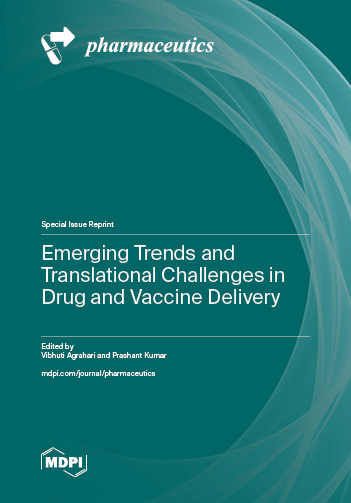Emerging Trends and Translational Challenges in Drug and Vaccine Delivery
A special issue of Pharmaceutics (ISSN 1999-4923). This special issue belongs to the section "Drug Delivery and Controlled Release".
Deadline for manuscript submissions: closed (30 September 2023) | Viewed by 21767
Special Issue Editors
Interests: biomaterials; biologics; long-term drug delivery; nanomedicine; hydrogels; ocular; inner ear
Special Issues, Collections and Topics in MDPI journals
Interests: vaccine; human vaccines; vaccine development; formulation development; attenuated vaccine; viral vaccines; bacterial vaccines; subunit vaccines; pediatric vaccines; COVID vaccines; measles and rubella vaccines; rotavirus vaccine; HPV vaccine; Shigella vaccine; Salmonella vaccine; combination vaccines; polio vaccine; stability study; potency assay; analytical assays; preclinical study; immunogenicity study; biophysical characterization; adjuvants; scale-up; technology transfer
Special Issues, Collections and Topics in MDPI journals
Special Issue Information
Dear Colleagues,
Drug and vaccine delivery are continuously progressing, and the developments in the past several decades have been enormous. Novel therapeutic modalities leverage advancements in long-term effects, controlled release, cocktail therapies, combinatorial methods, self-administration, and improved patient adherence by rationally designing innovative approaches for drug and vaccine delivery. Given the emerging trends and challenges, the comprehensive preclinical assessment of drug and vaccine delivery systems includes mechanistic chemistry, physicochemical characterizations, pre-formulation investigations, molecular pharmacology, and biological and toxicological evaluations. A better understanding of in vivo behavior, as well as the in vitro–in vivo characterization cascade of safety and efficacy testing, is needed to accelerate the translational challenges in developing a drug product from the proof-of-concept stage to scale-up issues, reproducibility, manufacturing, and commercialization processes. This Special Issue aims to provide the readers with the recent advancements in drug and vaccine delivery and associated challenges from bench to clinic and reflects on the pharma-/biotech- industrial applications. Research and review manuscripts focused on this theme are welcomed.
Dr. Vibhuti Agrahari
Dr. Prashant Kumar
Guest Editors
Manuscript Submission Information
Manuscripts should be submitted online at www.mdpi.com by registering and logging in to this website. Once you are registered, click here to go to the submission form. Manuscripts can be submitted until the deadline. All submissions that pass pre-check are peer-reviewed. Accepted papers will be published continuously in the journal (as soon as accepted) and will be listed together on the special issue website. Research articles, review articles as well as short communications are invited. For planned papers, a title and short abstract (about 100 words) can be sent to the Editorial Office for announcement on this website.
Submitted manuscripts should not have been published previously, nor be under consideration for publication elsewhere (except conference proceedings papers). All manuscripts are thoroughly refereed through a single-blind peer-review process. A guide for authors and other relevant information for submission of manuscripts is available on the Instructions for Authors page. Pharmaceutics is an international peer-reviewed open access monthly journal published by MDPI.
Please visit the Instructions for Authors page before submitting a manuscript. The Article Processing Charge (APC) for publication in this open access journal is 2900 CHF (Swiss Francs). Submitted papers should be well formatted and use good English. Authors may use MDPI's English editing service prior to publication or during author revisions.
Keywords
- biomaterials and polymer chemistry
- novel drug delivery designs
- sustained/controlled release
- vaccine delivery systems
- DNA and gene vaccine delivery
- delivery of mRNA vaccines
- biomedical applications
- development of 3D/organoids models to study delivery system
- in vivo imaging techniques for drug delivery system
- application of microfluidics, QbD, and PAT approaches in manufacturing, as well as scale-up techniques







